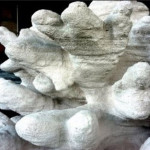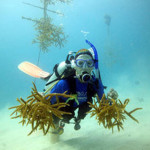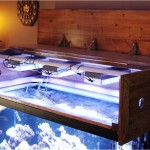Tag Archives: Reef

3D printing set to revolutionize artificial reefs
Making reef structures from cement has long been used as a technique to try to restore or create new reefs. The cement reefs do work but are associated with several different problems. One of them is that cement isn’t pH neutral and that coral larvae therefore do not settle on them in the amounts that is desired. Another method used to create fake reef is to use metal structures with a low electric current running through them. This quickly calcifies the tubes and promote coral growth. This method can however be expensive and requires access to electricity. This can be hard to provide in areas where solar cells are likely to be stolen by local fishermen..
SOI, 3D program specialist James Gardiner and Reef Arabia is now pioneering a new method of creating artificial reefs that might turn out to be a better alternative. Using a 3D printer to print reefs. They have developed a 3d printer than can print out reefs in a sand stone material. They have allready made and submersed two reefs. There are many benefits with this process says the forum group.
- The sand stone is pH neutral.
- It is possible to print any form with ease. This allows for more vertical surfaces where coral larvae like to attach themselves.
- A lot more complex designs are possible. 3D printing can easily create caves, crevices and other complex forms that would not be possible to do in cement.
- It is easy to use different designs which allows to create a lot more complex reefs (using different designed pieces). A more complex reef will offer suitable living space for more species.
- Sand stone has a smaller eco footprint than concrete as a lot less co2 is released in process.
- 3D printing can allow for more rapid production of artificial reef. At this point it takes 1 day to print one 5m reef unit and 4 of those can be printed simultaneous. A complex reef structure take about 1 week to design in the computer
It is still not certain that this technique will prove to be quicker and more cost efficient than currently used methods of creating reefs but Reef Arabia remain optimistic and it seems likely that prices will keep going down as 3D printing evolves. Even if ends up being a slightly more expensive method it might still be worth using since it allows for more complex and more natural artificial reefs.

Join your local garden club, help ”plant” corals
Working with corals might not be the first thing that comes to mind when you think about a local garden club. That is however exactly what you would be doing if you where a member of the Garden Club of the Upper Keys. They are trying to help restore corals in the local area by propagating and relocating corals.
“Gardening underwater? Yes, we’re helping to restore our precious coral reefs,” says club President Marilyn Rogers.
The Garden Club of the Upper Keys is indeed a garden club in more than only name and is a member of the Florida Federation of Garden Clubs. Florida Federation of Garden Clubs has 13,000 members in 200 clubs and have chosen to welcome the Key Largo-based Coral Restoration Foundation as a yearlong member. The fundation is helping fund the restoration work on a designated reef site on French Reef in the Upper Keys
The members of the two usually unrelated disciplines say that there are many similarities between regular gardening and ”underwater gardening”. (like most reef keepers already now)) The “right plant, right place” is as an example an important adage in both types of gardening. The process of producing and replanting plants in your garden is also rather similar.
“First the coral is grown in a nursery until it is strong enough to be attached to the reef,” Rogers said. “The branching corals are then gathered and moved to the protected staghorn or elkhorn coral areas. Site selection and preparation are key elements for success. The gardener diver decides where to site the coral, in what position and preps the spot. The corals are attached with special marine epoxy.”
To find out more, go to www.coralrestoration.org.
Lightning Maroon Clownfish
The lightning Maroon Clownfish is a one of a kind truly stunning clown fish that was caught of Papua New Guinea. One of a kind fish like this usually go to people willing to pay biiiig money for them but in this case Blue Zoo Aquatics opted to make sure that it went to an established breeder instead to make sure that we all might get to enjoy these stunning color morph in the future. It would not be the first time a new color morph has been developed form a single original fish.
Although the lightning Maroon Clownfish paired of last year (2011) the pair has so far not laid any eggs or produced any offspring.
Pairing video:
The breeder has now decided to try to use a technique called “Double down” in which you move a batch of eggs another couple laid to the couple you want to start breeding. The idea is that either the fish start caring for the eggs that are given to them, which usually triggers them to start laying their own egg before long, or they eat the eggs that are given to them and get a very nutritious meal. In this case, the eggs, taken from an Onyx Percula spawning, were received somewhat well and the pair is showing signs of caring for the eggs which might be a good sign and hopefully we will get to see baby lightning Maroon Clownfish before long. If you want more info or keep up to date with the attempts to spawn the lightning Maroon Clown fish you can visit the lightning project website and if you want more info on this particular breeding attempt you can click here.
The lightning Maroon Clownfish guarding the new eggs:

Reef Lighting
This article was written by myself and Cliff. The first part was written by me (Dave66), and Cliff gives an overview of LED (Light Emitting Diode) lighting.
—-
Perhaps the most important and vital piece of equipment one can buy for their reef aquarium is lighting.
Fully 95 percent of corals available in shops and online are photosynthetic. That is, they have photosynthetic bacteria in their tissues (zooxanthellae). The bacteria ‘feed’ on the light, and the sugars they produce as waste feeds the coral.
On the tropical reef it’s the sun that powers the photosynthesis of zooxanthellae. In the aquarium, it is the responsibility of the keeper to simulate the sun in their aquariums. Lighting is one of the major costs in starting a reef tank. Continue reading
Marine Reactors
Reactors
In marine aquariums, available are several types of reactors. Reactors are simply acrylic cylinders that contain some type of media. Internal construction varies, depending on the brand and type of reactor.
What follows are reactor types and their purpose.
—–
Perhaps the most valuable of the reactors in a reef aquarium is a Calcium Reactor.
Maintaining natural sea water levels of minerals and trace elements, and alkalinity of a sufficient level to buffer them, is a challenge for many new and not so new reef aquarium keepers.
A Calcium Reactor can negate that challenge. The reactor is loaded with an aragonite media or similar, which as it dissolves, continually maintains natural sea water levels of minerals and trace elements, and the optimal level of alkalinity. Having a Calcium Reactor is cost effective in the long run, since it will keep you from having to buy products for the marine minerals and trace elements, plus alkalinity, regularly.
Reef Filtration
Reef Filtration
Though in smaller reef aquariums, the organisms in live rock and sand process Nitrate, reducing it naturally to zero. In larger reefs, that is over 90 gallons in size, with more life in, filters can help in keeping it at zero
However, there are several types of filtration that can help keeping your water quality high.